ACCT210: Cost and Management Accounting - Labour Cost Analysis
VerifiedAdded on 2022/06/07
|6
|1378
|43
Homework Assignment
AI Summary
This assignment, prepared by Aliyah Amisha Ali for ACCT210 at the College of Science, Technology and Applied Arts of Trinidad and Tobago, provides a comprehensive overview of labour cost accounting. It begins by defining and differentiating between direct and indirect labour costs, highlighting their impact on prime and overhead costs. The document then delves into various remuneration methods, including time-based and piecework systems, and explores different types of piecework systems, along with incentive schemes. The assignment further examines the causes and costs associated with labour turnover, distinguishing between avoidable and unavoidable factors, and discusses both replacement and preventative costs. Finally, it covers key labour efficiency, capacity, and production volume ratios, including calculations for each, providing a practical understanding of how to measure and analyze workforce performance.
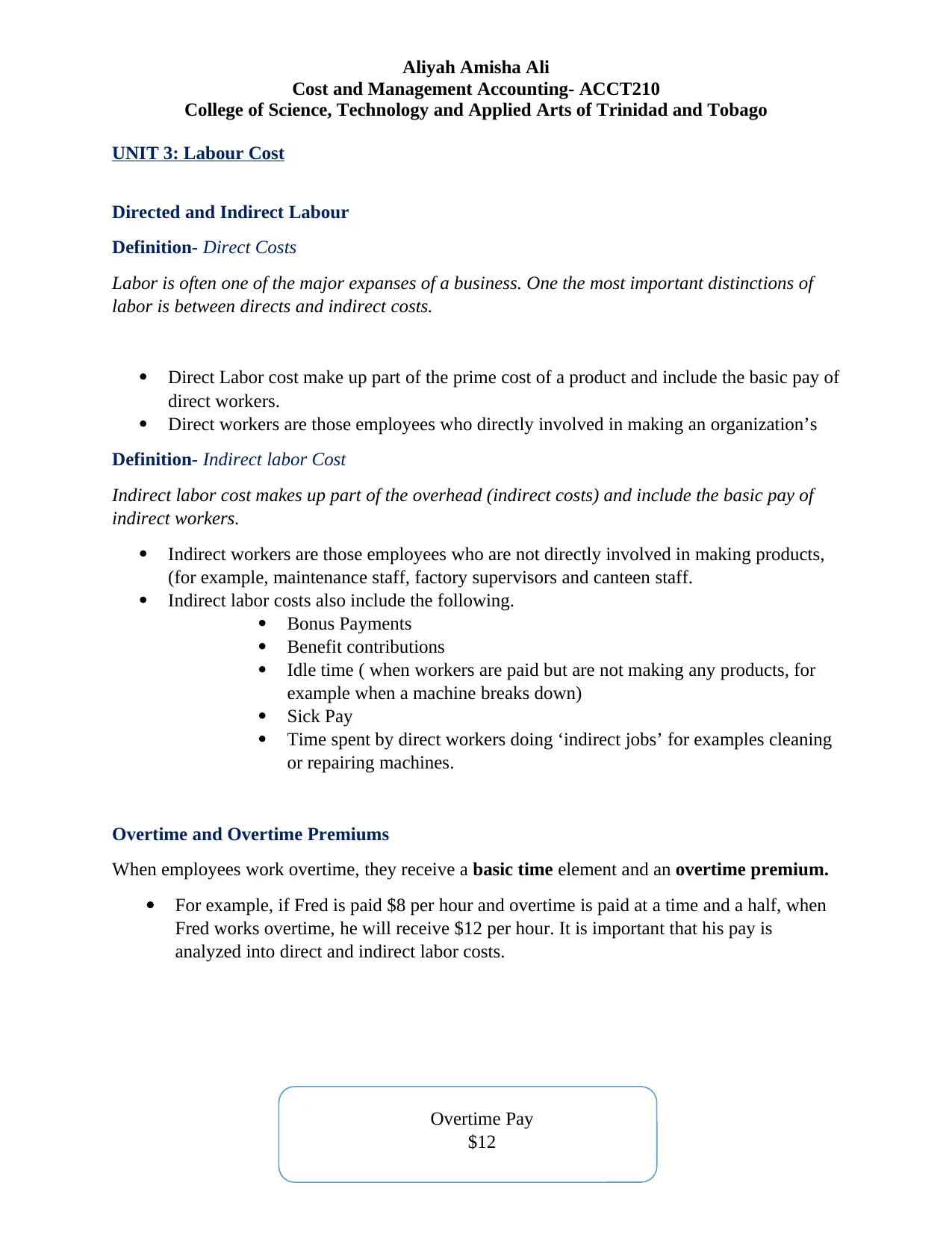
Aliyah Amisha Ali
Cost and Management Accounting- ACCT210
College of Science, Technology and Applied Arts of Trinidad and Tobago
UNIT 3: Labour Cost
Directed and Indirect Labour
Definition- Direct Costs
Labor is often one of the major expanses of a business. One the most important distinctions of
labor is between directs and indirect costs.
Direct Labor cost make up part of the prime cost of a product and include the basic pay of
direct workers.
Direct workers are those employees who directly involved in making an organization’s
Definition- Indirect labor Cost
Indirect labor cost makes up part of the overhead (indirect costs) and include the basic pay of
indirect workers.
Indirect workers are those employees who are not directly involved in making products,
(for example, maintenance staff, factory supervisors and canteen staff.
Indirect labor costs also include the following.
Bonus Payments
Benefit contributions
Idle time ( when workers are paid but are not making any products, for
example when a machine breaks down)
Sick Pay
Time spent by direct workers doing ‘indirect jobs’ for examples cleaning
or repairing machines.
Overtime and Overtime Premiums
When employees work overtime, they receive a basic time element and an overtime premium.
For example, if Fred is paid $8 per hour and overtime is paid at a time and a half, when
Fred works overtime, he will receive $12 per hour. It is important that his pay is
analyzed into direct and indirect labor costs.
Overtime Pay
$12
Cost and Management Accounting- ACCT210
College of Science, Technology and Applied Arts of Trinidad and Tobago
UNIT 3: Labour Cost
Directed and Indirect Labour
Definition- Direct Costs
Labor is often one of the major expanses of a business. One the most important distinctions of
labor is between directs and indirect costs.
Direct Labor cost make up part of the prime cost of a product and include the basic pay of
direct workers.
Direct workers are those employees who directly involved in making an organization’s
Definition- Indirect labor Cost
Indirect labor cost makes up part of the overhead (indirect costs) and include the basic pay of
indirect workers.
Indirect workers are those employees who are not directly involved in making products,
(for example, maintenance staff, factory supervisors and canteen staff.
Indirect labor costs also include the following.
Bonus Payments
Benefit contributions
Idle time ( when workers are paid but are not making any products, for
example when a machine breaks down)
Sick Pay
Time spent by direct workers doing ‘indirect jobs’ for examples cleaning
or repairing machines.
Overtime and Overtime Premiums
When employees work overtime, they receive a basic time element and an overtime premium.
For example, if Fred is paid $8 per hour and overtime is paid at a time and a half, when
Fred works overtime, he will receive $12 per hour. It is important that his pay is
analyzed into direct and indirect labor costs.
Overtime Pay
$12
Paraphrase This Document
Need a fresh take? Get an instant paraphrase of this document with our AI Paraphraser
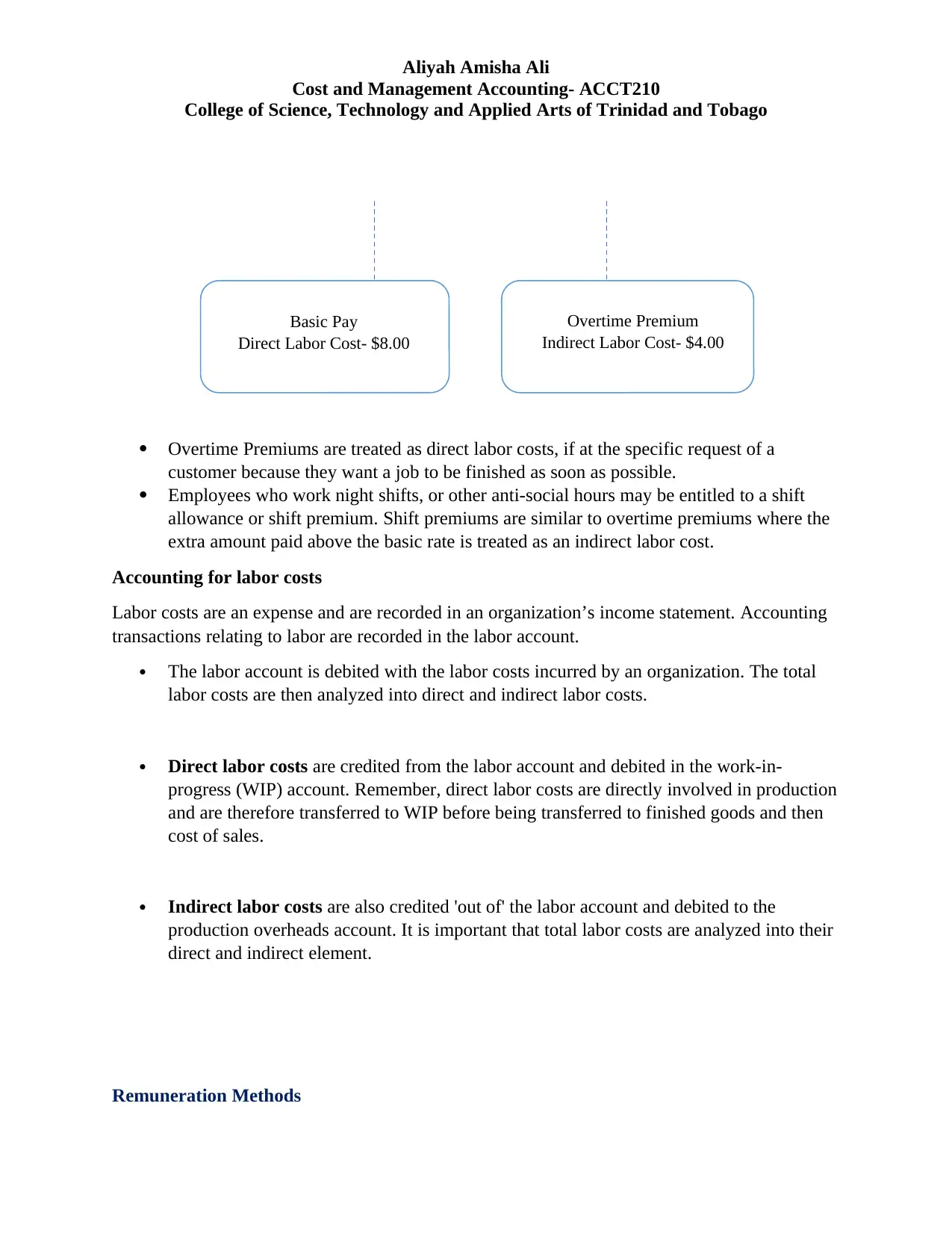
Aliyah Amisha Ali
Cost and Management Accounting- ACCT210
College of Science, Technology and Applied Arts of Trinidad and Tobago
Overtime Premiums are treated as direct labor costs, if at the specific request of a
customer because they want a job to be finished as soon as possible.
Employees who work night shifts, or other anti-social hours may be entitled to a shift
allowance or shift premium. Shift premiums are similar to overtime premiums where the
extra amount paid above the basic rate is treated as an indirect labor cost.
Accounting for labor costs
Labor costs are an expense and are recorded in an organization’s income statement. Accounting
transactions relating to labor are recorded in the labor account.
The labor account is debited with the labor costs incurred by an organization. The total
labor costs are then analyzed into direct and indirect labor costs.
Direct labor costs are credited from the labor account and debited in the work-in-
progress (WIP) account. Remember, direct labor costs are directly involved in production
and are therefore transferred to WIP before being transferred to finished goods and then
cost of sales.
Indirect labor costs are also credited 'out of' the labor account and debited to the
production overheads account. It is important that total labor costs are analyzed into their
direct and indirect element.
Remuneration Methods
Basic Pay
Direct Labor Cost- $8.00
Overtime Premium
Indirect Labor Cost- $4.00
Cost and Management Accounting- ACCT210
College of Science, Technology and Applied Arts of Trinidad and Tobago
Overtime Premiums are treated as direct labor costs, if at the specific request of a
customer because they want a job to be finished as soon as possible.
Employees who work night shifts, or other anti-social hours may be entitled to a shift
allowance or shift premium. Shift premiums are similar to overtime premiums where the
extra amount paid above the basic rate is treated as an indirect labor cost.
Accounting for labor costs
Labor costs are an expense and are recorded in an organization’s income statement. Accounting
transactions relating to labor are recorded in the labor account.
The labor account is debited with the labor costs incurred by an organization. The total
labor costs are then analyzed into direct and indirect labor costs.
Direct labor costs are credited from the labor account and debited in the work-in-
progress (WIP) account. Remember, direct labor costs are directly involved in production
and are therefore transferred to WIP before being transferred to finished goods and then
cost of sales.
Indirect labor costs are also credited 'out of' the labor account and debited to the
production overheads account. It is important that total labor costs are analyzed into their
direct and indirect element.
Remuneration Methods
Basic Pay
Direct Labor Cost- $8.00
Overtime Premium
Indirect Labor Cost- $4.00
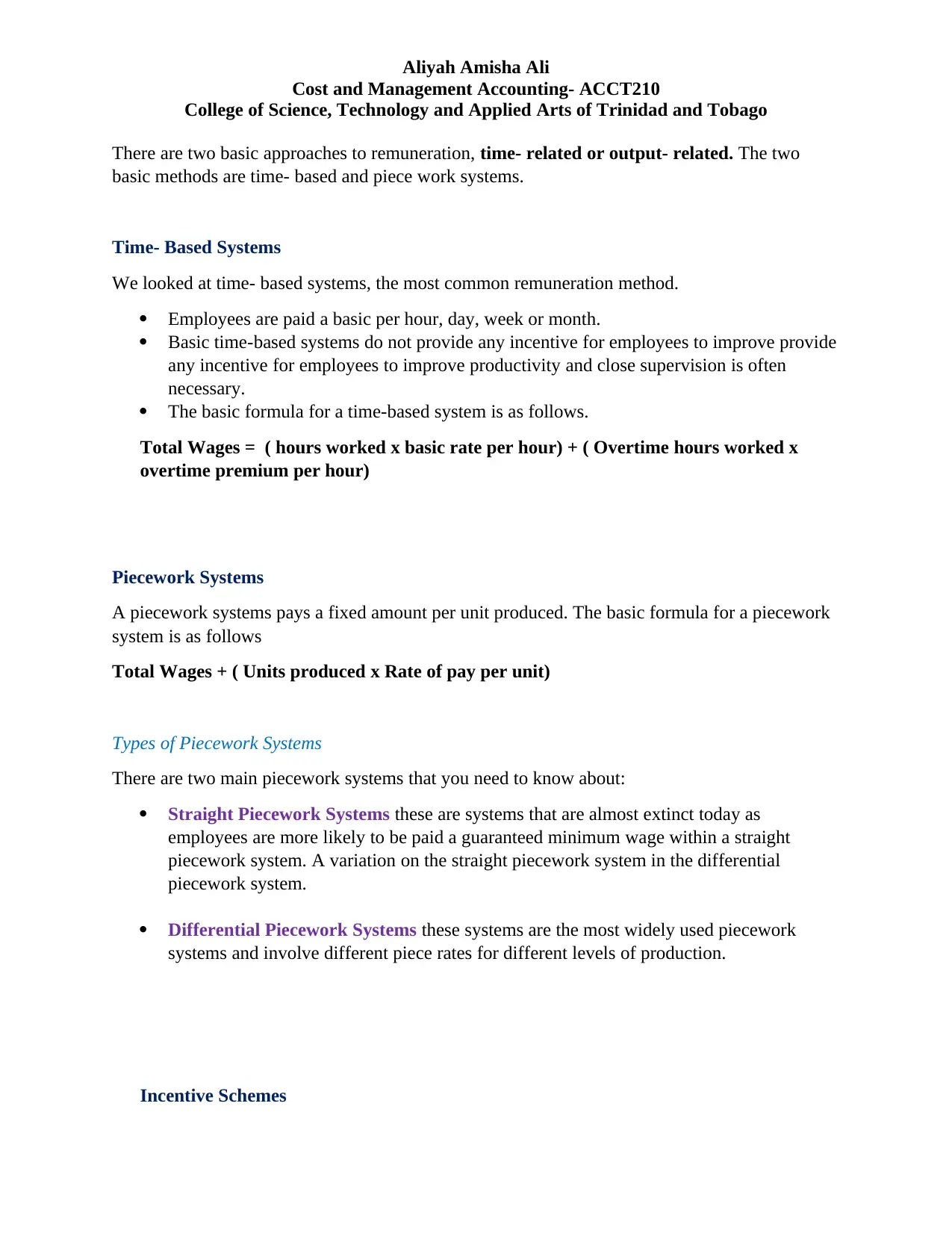
Aliyah Amisha Ali
Cost and Management Accounting- ACCT210
College of Science, Technology and Applied Arts of Trinidad and Tobago
There are two basic approaches to remuneration, time- related or output- related. The two
basic methods are time- based and piece work systems.
Time- Based Systems
We looked at time- based systems, the most common remuneration method.
Employees are paid a basic per hour, day, week or month.
Basic time-based systems do not provide any incentive for employees to improve provide
any incentive for employees to improve productivity and close supervision is often
necessary.
The basic formula for a time-based system is as follows.
Total Wages = ( hours worked x basic rate per hour) + ( Overtime hours worked x
overtime premium per hour)
Piecework Systems
A piecework systems pays a fixed amount per unit produced. The basic formula for a piecework
system is as follows
Total Wages + ( Units produced x Rate of pay per unit)
Types of Piecework Systems
There are two main piecework systems that you need to know about:
Straight Piecework Systems these are systems that are almost extinct today as
employees are more likely to be paid a guaranteed minimum wage within a straight
piecework system. A variation on the straight piecework system in the differential
piecework system.
Differential Piecework Systems these systems are the most widely used piecework
systems and involve different piece rates for different levels of production.
Incentive Schemes
Cost and Management Accounting- ACCT210
College of Science, Technology and Applied Arts of Trinidad and Tobago
There are two basic approaches to remuneration, time- related or output- related. The two
basic methods are time- based and piece work systems.
Time- Based Systems
We looked at time- based systems, the most common remuneration method.
Employees are paid a basic per hour, day, week or month.
Basic time-based systems do not provide any incentive for employees to improve provide
any incentive for employees to improve productivity and close supervision is often
necessary.
The basic formula for a time-based system is as follows.
Total Wages = ( hours worked x basic rate per hour) + ( Overtime hours worked x
overtime premium per hour)
Piecework Systems
A piecework systems pays a fixed amount per unit produced. The basic formula for a piecework
system is as follows
Total Wages + ( Units produced x Rate of pay per unit)
Types of Piecework Systems
There are two main piecework systems that you need to know about:
Straight Piecework Systems these are systems that are almost extinct today as
employees are more likely to be paid a guaranteed minimum wage within a straight
piecework system. A variation on the straight piecework system in the differential
piecework system.
Differential Piecework Systems these systems are the most widely used piecework
systems and involve different piece rates for different levels of production.
Incentive Schemes
⊘ This is a preview!⊘
Do you want full access?
Subscribe today to unlock all pages.

Trusted by 1+ million students worldwide
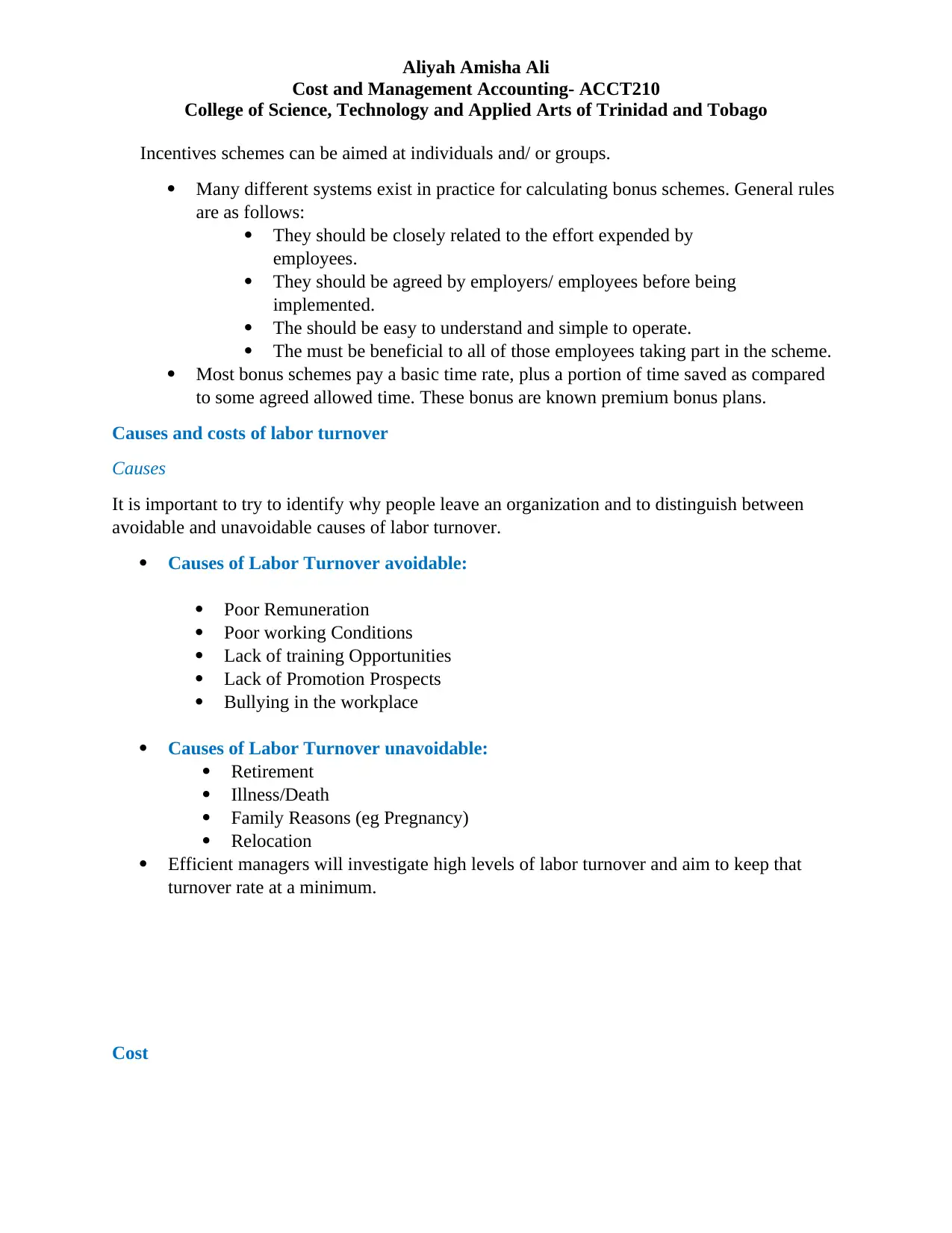
Aliyah Amisha Ali
Cost and Management Accounting- ACCT210
College of Science, Technology and Applied Arts of Trinidad and Tobago
Incentives schemes can be aimed at individuals and/ or groups.
Many different systems exist in practice for calculating bonus schemes. General rules
are as follows:
They should be closely related to the effort expended by
employees.
They should be agreed by employers/ employees before being
implemented.
The should be easy to understand and simple to operate.
The must be beneficial to all of those employees taking part in the scheme.
Most bonus schemes pay a basic time rate, plus a portion of time saved as compared
to some agreed allowed time. These bonus are known premium bonus plans.
Causes and costs of labor turnover
Causes
It is important to try to identify why people leave an organization and to distinguish between
avoidable and unavoidable causes of labor turnover.
Causes of Labor Turnover avoidable:
Poor Remuneration
Poor working Conditions
Lack of training Opportunities
Lack of Promotion Prospects
Bullying in the workplace
Causes of Labor Turnover unavoidable:
Retirement
Illness/Death
Family Reasons (eg Pregnancy)
Relocation
Efficient managers will investigate high levels of labor turnover and aim to keep that
turnover rate at a minimum.
Cost
Cost and Management Accounting- ACCT210
College of Science, Technology and Applied Arts of Trinidad and Tobago
Incentives schemes can be aimed at individuals and/ or groups.
Many different systems exist in practice for calculating bonus schemes. General rules
are as follows:
They should be closely related to the effort expended by
employees.
They should be agreed by employers/ employees before being
implemented.
The should be easy to understand and simple to operate.
The must be beneficial to all of those employees taking part in the scheme.
Most bonus schemes pay a basic time rate, plus a portion of time saved as compared
to some agreed allowed time. These bonus are known premium bonus plans.
Causes and costs of labor turnover
Causes
It is important to try to identify why people leave an organization and to distinguish between
avoidable and unavoidable causes of labor turnover.
Causes of Labor Turnover avoidable:
Poor Remuneration
Poor working Conditions
Lack of training Opportunities
Lack of Promotion Prospects
Bullying in the workplace
Causes of Labor Turnover unavoidable:
Retirement
Illness/Death
Family Reasons (eg Pregnancy)
Relocation
Efficient managers will investigate high levels of labor turnover and aim to keep that
turnover rate at a minimum.
Cost
Paraphrase This Document
Need a fresh take? Get an instant paraphrase of this document with our AI Paraphraser
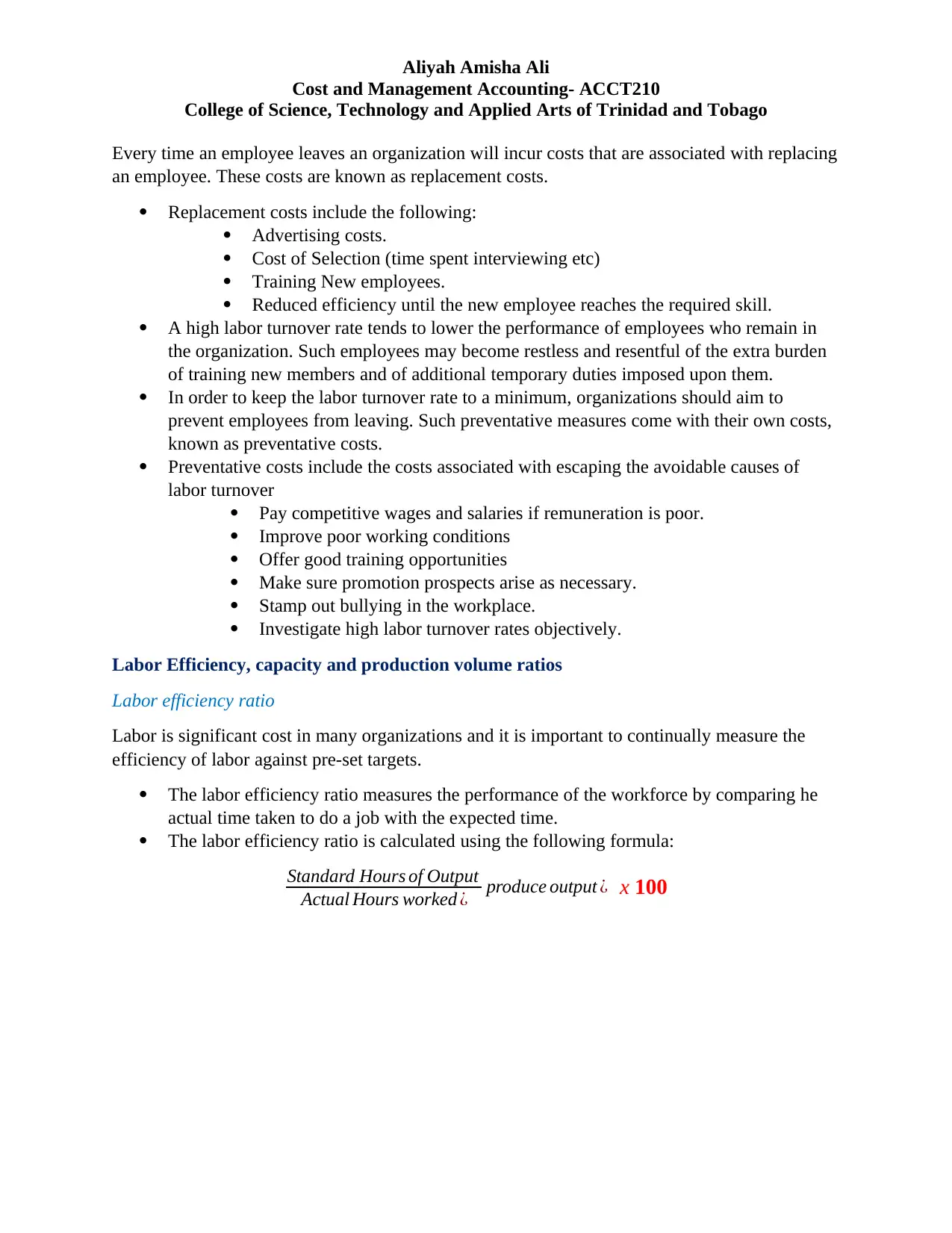
Aliyah Amisha Ali
Cost and Management Accounting- ACCT210
College of Science, Technology and Applied Arts of Trinidad and Tobago
Every time an employee leaves an organization will incur costs that are associated with replacing
an employee. These costs are known as replacement costs.
Replacement costs include the following:
Advertising costs.
Cost of Selection (time spent interviewing etc)
Training New employees.
Reduced efficiency until the new employee reaches the required skill.
A high labor turnover rate tends to lower the performance of employees who remain in
the organization. Such employees may become restless and resentful of the extra burden
of training new members and of additional temporary duties imposed upon them.
In order to keep the labor turnover rate to a minimum, organizations should aim to
prevent employees from leaving. Such preventative measures come with their own costs,
known as preventative costs.
Preventative costs include the costs associated with escaping the avoidable causes of
labor turnover
Pay competitive wages and salaries if remuneration is poor.
Improve poor working conditions
Offer good training opportunities
Make sure promotion prospects arise as necessary.
Stamp out bullying in the workplace.
Investigate high labor turnover rates objectively.
Labor Efficiency, capacity and production volume ratios
Labor efficiency ratio
Labor is significant cost in many organizations and it is important to continually measure the
efficiency of labor against pre-set targets.
The labor efficiency ratio measures the performance of the workforce by comparing he
actual time taken to do a job with the expected time.
The labor efficiency ratio is calculated using the following formula:
Standard Hours of Output
Actual Hours worked ¿ produce output ¿ x 100
Cost and Management Accounting- ACCT210
College of Science, Technology and Applied Arts of Trinidad and Tobago
Every time an employee leaves an organization will incur costs that are associated with replacing
an employee. These costs are known as replacement costs.
Replacement costs include the following:
Advertising costs.
Cost of Selection (time spent interviewing etc)
Training New employees.
Reduced efficiency until the new employee reaches the required skill.
A high labor turnover rate tends to lower the performance of employees who remain in
the organization. Such employees may become restless and resentful of the extra burden
of training new members and of additional temporary duties imposed upon them.
In order to keep the labor turnover rate to a minimum, organizations should aim to
prevent employees from leaving. Such preventative measures come with their own costs,
known as preventative costs.
Preventative costs include the costs associated with escaping the avoidable causes of
labor turnover
Pay competitive wages and salaries if remuneration is poor.
Improve poor working conditions
Offer good training opportunities
Make sure promotion prospects arise as necessary.
Stamp out bullying in the workplace.
Investigate high labor turnover rates objectively.
Labor Efficiency, capacity and production volume ratios
Labor efficiency ratio
Labor is significant cost in many organizations and it is important to continually measure the
efficiency of labor against pre-set targets.
The labor efficiency ratio measures the performance of the workforce by comparing he
actual time taken to do a job with the expected time.
The labor efficiency ratio is calculated using the following formula:
Standard Hours of Output
Actual Hours worked ¿ produce output ¿ x 100
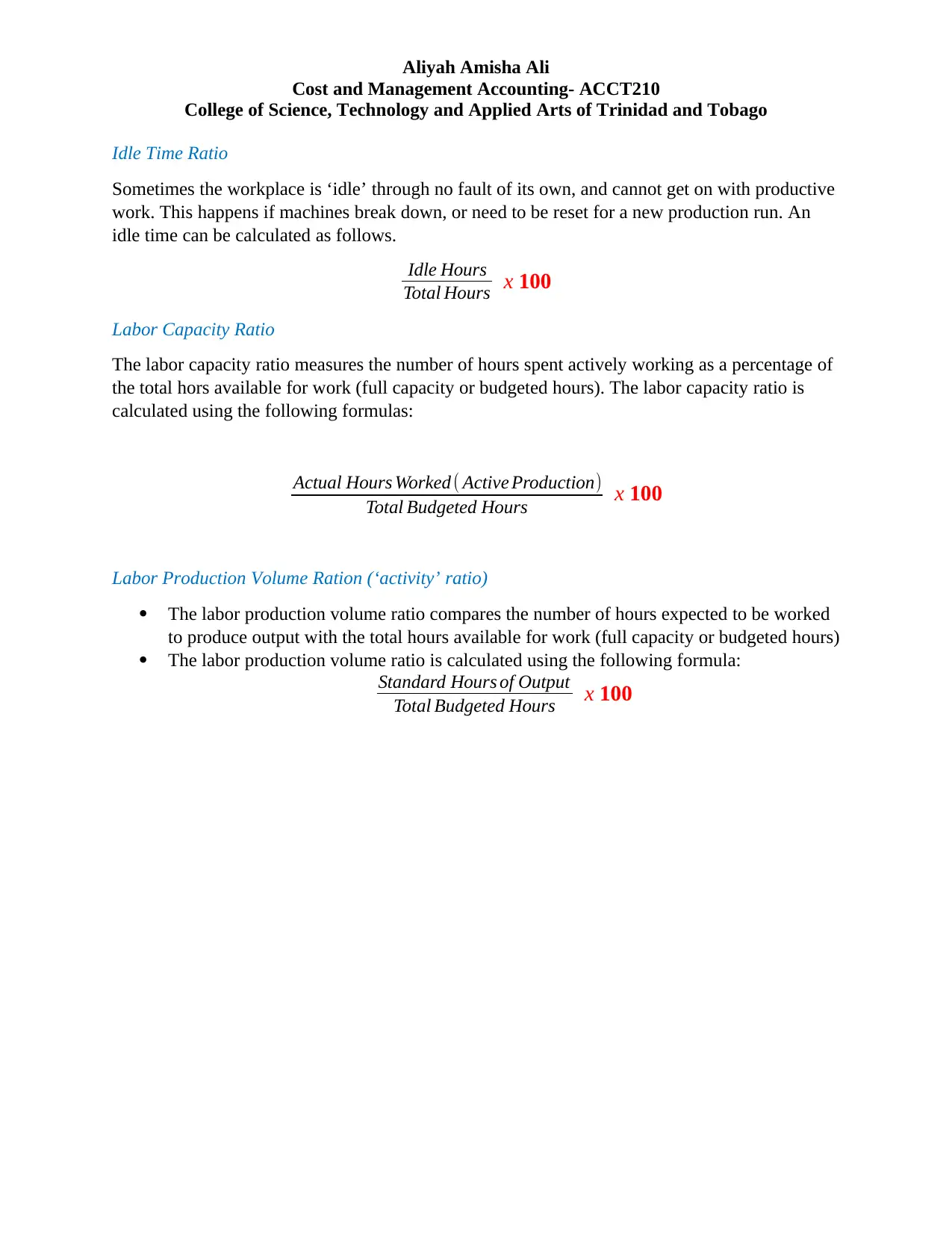
Aliyah Amisha Ali
Cost and Management Accounting- ACCT210
College of Science, Technology and Applied Arts of Trinidad and Tobago
Idle Time Ratio
Sometimes the workplace is ‘idle’ through no fault of its own, and cannot get on with productive
work. This happens if machines break down, or need to be reset for a new production run. An
idle time can be calculated as follows.
Idle Hours
Total Hours x 100
Labor Capacity Ratio
The labor capacity ratio measures the number of hours spent actively working as a percentage of
the total hors available for work (full capacity or budgeted hours). The labor capacity ratio is
calculated using the following formulas:
Actual Hours Worked ( Active Production)
Total Budgeted Hours x 100
Labor Production Volume Ration (‘activity’ ratio)
The labor production volume ratio compares the number of hours expected to be worked
to produce output with the total hours available for work (full capacity or budgeted hours)
The labor production volume ratio is calculated using the following formula:
Standard Hours of Output
Total Budgeted Hours x 100
Cost and Management Accounting- ACCT210
College of Science, Technology and Applied Arts of Trinidad and Tobago
Idle Time Ratio
Sometimes the workplace is ‘idle’ through no fault of its own, and cannot get on with productive
work. This happens if machines break down, or need to be reset for a new production run. An
idle time can be calculated as follows.
Idle Hours
Total Hours x 100
Labor Capacity Ratio
The labor capacity ratio measures the number of hours spent actively working as a percentage of
the total hors available for work (full capacity or budgeted hours). The labor capacity ratio is
calculated using the following formulas:
Actual Hours Worked ( Active Production)
Total Budgeted Hours x 100
Labor Production Volume Ration (‘activity’ ratio)
The labor production volume ratio compares the number of hours expected to be worked
to produce output with the total hours available for work (full capacity or budgeted hours)
The labor production volume ratio is calculated using the following formula:
Standard Hours of Output
Total Budgeted Hours x 100
⊘ This is a preview!⊘
Do you want full access?
Subscribe today to unlock all pages.

Trusted by 1+ million students worldwide
1 out of 6
Related Documents
Your All-in-One AI-Powered Toolkit for Academic Success.
+13062052269
info@desklib.com
Available 24*7 on WhatsApp / Email
![[object Object]](/_next/static/media/star-bottom.7253800d.svg)
Unlock your academic potential
Copyright © 2020–2025 A2Z Services. All Rights Reserved. Developed and managed by ZUCOL.



